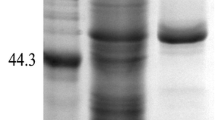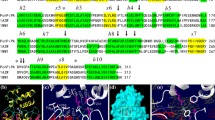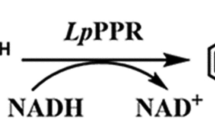Abstract
In this study, the prokaryotic expression system of Escherichia coli was used to modify prolyl aminopeptidase derived from Aspergillus oryzae JN-412 (AoPAP) via random mutagenesis and site-directed saturation mutagenesis. A random mutant library with a capacity of approximately 3000 mutants was compiled using error-prone polymerase chain reaction, and nonconservative amino acids within 3 Å of the substrate L-proline-p-nitroaniline were selected as site-directed saturation mutagenesis sites via homologous simulation and molecular docking of AoPAP. Variants featuring high catalytic efficiency were screened by a high-throughput screening method. The specific activities of the variants of 3D9, C185V, and Y393W were 127 U mg−1, 156 U mg−1, and 120 U mg−1, respectively, which were 27%, 56%, and 20% higher than those of the wild type, with a value of 100 U mg−1. The half-life of thermostability of the mutant 3D9 was 4.5 h longer than that of the wild type at 50 °C. The mutant C185V improved thermostability and had a half-life 2 h longer than that of the wild type at a pH of 6.5. Prolyl aminopeptidase had improved stability within the acidic range and thermostability after modification, making it more suitable for a synergistic combination with various acidic and neutral endoproteases.





Similar content being viewed by others
References
Szawlowska, U., Zdunek-Zastocka, E., & Bielawski, W. (2011). Biochemical characterisation of prolyl aminopeptidase from shoots of triticale seedlings and its activity changes in response to suboptimal growth conditions. Plant Physiology and Biochemistry, 49(11), 1342–1349.
Mika, N., Zorn, H., & Ruhl, M. (2015). Prolyl-specific peptidases for applications in food protein hydrolysis. Applied Microbiology and Biotechnology, 99(19), 7837–7846.
Rosenblum, J. S., & Kozarich, J. W. (2003). Prolyl peptidases: a serine protease subfamily with high potential for drug discovery. Current Opinion in Chemical Biology, 7(4), 496–504.
Juillerat-Jeanneret, L. (2008). Prolyl-specific peptidases and their inhibitors in biological processes. Current Chemical Biology, 2, 97–109.
Murai, A., Tsujimoto, Y., Matsui, H., & Watanabe, K. (2004). An Aneurinibacillus sp. strain AM-1 produces a proline-specific aminopeptidase useful for collagen degradation. Journal of Applied Microbiology, 96(4), 810–818.
Izawa, N., Ishikawa, S., Tanokura, T., Ohta, K., & Hayashi, K. (1997). Purification and characterization of Aeromonas caviae aminopeptidase possessing debittering activity. Journal of Agricultural and Food Chemistry, 45, 4897–4902.
Lin, S. J., Chen, Y.-H., Chen, L.-L., Feng, H.-H., Chen, C.-C., & Chu, W.-S. (2008). Large-scale production and application of leucine aminopeptidase produced by Aspergillus oryzae LL1 for hydrolysis of chicken breast meat. European Food Research and Technology, 227, 159–165.
Rawlings, N. D., Tolle, D. P., & Barrett, A. J. (2004). MEROPS: the peptidase database. Nucleic Acids Research, 32(Database issue), D160–D164.
Polgar, L. (2005). The catalytic triad of serine peptidases. Cellular and Molecular Life Sciences, 62(19-20), 2161–2172.
Morel, F., Gilbert, C., Geourjon, C., Frot-Coutaz, J., & Atlan, D. (1999). The prolyl aminopeptidase from Lactobacillus delbrueckii subsp. bulgaricus belongs to the α/β hydrolase fold family. Biochimica et Biophysica Acta, 1429(2), 501–505.
Polgár, L. (2002). The prolyl oligopeptidase family. Cellular & Molecular Life Sciences Cmls, 59(2), 349–362.
Albertson, N. H., & Koomey, M. (2006). Molecular cloning and characterization of a proline iminopeptidase gene from Neisseria gonorrhoeae. Molecular Microbiology, 9, 1203–1211.
Kitazono, A., Kitano, A., Tsuru, D., & Yoshimoto, T. (1994). Isolation and characterization of the prolyl aminopeptidase gene (pap) from Aeromonas sobria: comparison with the Bacillus coagulans enzyme. Journal of Biochemistry, 116, 818–825.
Li, N., Wu, J. M., Zhang, L. F., Zhang, Y. Z., & Feng, H. (2010). Characterization of a unique proline iminopeptidase from white-rot basidiomycetes Phanerochaete chrysosporium. Biochimie, 92(7), 779–788.
Basten, D. E., Moers, A. P., Ooyen, A. J., & Schaap, P. J. (2005). Characterisation of Aspergillus niger prolyl aminopeptidase. Molecular Genetics and Genomics, 272, 673–679.
Yamamoto, Y., Usuki, H., Iwabuchi, M., & Hatanaka, T. (2010). Prolyl aminopeptidase from Streptomyces thermoluteus subsp. fuscus strain NBRC14270 and synthesis of proline-containing peptides by its S144C variant. Applied and Environmental Microbiology, 76(18), 6180–6185.
Matsushita-Morita, M., Furukawa, I., Suzuki, S., Yamagata, Y., Koide, Y., Ishida, H., Takeuchi, M., Kashiwagi, Y., & Kusumoto, K. I. (2010). Characterization of recombinant prolyl aminopeptidase from Aspergillus oryzae. Journal of Applied Microbiology, 109, 156–165.
Nandan, A., Pandey, A., & Nampoothiri, K. M. (2011). Proline-specific extracellular aminopeptidase purified from Streptomyces lavendulae. Applied Biochemistry and Biotechnology, 163, 994–1001.
Zdunek-Zastocka, E., Grabowska, A., Branicki, T., & Michniewska, B. (2017). Biochemical characterization of the triticale TsPAP1, a new type of plant prolyl aminopeptidase, and its impact on proline content and flowering time in transgenic Arabidopsis plants. Plant Physiology and Biochemistry, 116, 18–26.
Sun, X., Wang, F., Cai, H., Zhao, C., Ji, W., & Zhu, Y. (2013). Functional characterization of an Arabidopsis prolyl aminopeptidase AtPAP1 in response to salt and drought stresses. Plant Cell, Tissue and Organ Culture (PCTOC), 114, 325–338.
Mane, S., Gade, W., & Jamdar, S. (2011). Purification and characterization of proline aminopeptidase from chicken intestine. Process Biochemistry, 46, 1384–1389.
Bolumar, T., Sanz, Y., Aristoy, M. C., & Toldra, F. (2003). Purification and characterization of a prolyl aminopeptidase from Debaryomyces hansenii. Applied and Environmental Microbiology, 69(1), 227–232.
Uraji, M., Arima, J., Uesugi, Y., Iwabuchi, M., & Hatanaka, T. (2007). Effect of salt on the activity of Streptomyces prolyl aminopeptidase. Biochimica et Biophysica Acta, 1774(11), 1462–1469.
Mahon, C. S., O’Donoghue, A. J., Goetz, D. H., Murray, P. G., Craik, C. S., & Tuohy, M. G. (2009). Characterization of a multimeric, eukaryotic prolyl aminopeptidase: an inducible and highly specific intracellular peptidase from the non-pathogenic fungus Talaromyces emersonii. Microbiology, 155(Pt 11), 3673–3682.
Iyer, S., La-Borde, P. J., Payne, K. A., Parsons, M. R., Turner, A. J., Isaac, R. E., & Acharya, K. R. (2015). Crystal structure of X-prolyl aminopeptidase from Caenorhabditis elegans: a cytosolic enzyme with a di-nuclear active site. FEBS Open Bio, 5, 292–302.
Wang, K., Tian, Y., Zhou, N., Liu, D., & Zhang, D. (2018). Studies on fermentation optimization, stability and application of prolyl aminopeptidase from Bacillus subtilis. Process Biochemistry, 74, 10–20.
Jing, Z., & Feng, H. (2015). Studies on the molecular docking and amino acid residues involving in recognition of substrate in proline iminopeptidase by site-directed mutagenesis. The Protein Journal, 34(3), 173–180.
Ding, G. W., Zhou, N. D., & Tian, Y. P. (2014). Over-expression of a proline specific aminopeptidase from Aspergillus oryzae JN-412 and its application in collagen degradation. Applied Biochemistry and Biotechnology, 173(7), 1765–1777.
Wang, K. D., Wang, K. H., Zhou, N. D., & Tian, Y. P. (2017). Secretory expression, purification, characterization, and application of an Aspergillus oryzae prolyl aminopeptidase in Bacillus subtilis. Applied Biochemistry and Biotechnology, 181, 1611–1623.
Yang, H., Zhu, Q., Zhou, N., & Tian, Y. (2016). Optimized expression of prolyl aminopeptidase in Pichia pastoris and its characteristics after glycosylation. World Journal of Microbiology and Biotechnology, 32, 176.
Chica, R. A., Doucet, N., & Pelletier, J. N. (2005). Semi-rational approaches to engineering enzyme activity: combining the benefits of directed evolution and rational design. Current Opinion in Biotechnology, 16(4), 378–384.
Wu, Z., Deng, W., Tong, Y., Liao, Q., Xin, D., Yu, H., Feng, J., & Tang, L. (2017). Exploring the thermostable properties of halohydrin dehalogenase from Agrobacterium radiobacter AD1 by a combinatorial directed evolution strategy. Applied Microbiology and Biotechnology, 101(8), 3201–3211.
Li, Y., Yang, H., & Xu, F. (2018). Identifying and engineering a critical amino acid residue to enhance the catalytic efficiency of Pseudomonas sp. methyl parathion hydrolase. Applied Microbiology and Biotechnology, 102(15), 6537–6545.
de Souza, A. R., de Araujo, G. C., Zanphorlin, L. M., Ruller, R., Franco, F. C., Torres, F. A., Mertens, J. A., Bowman, M. J., Gomes, E., & Da Silva, R. (2016). Engineering increased thermostability in the GH-10 endo-1,4-beta-xylanase from Thermoascus aurantiacus CBMAI 756. International Journal of Biological Macromolecules, 93, 20–26.
Kong, X. D., Ma, Q., Zhou, J., Zeng, B. B., & Xu, J. H. (2014). A smart library of epoxide hydrolase variants and the top hits for synthesis of (S)-beta-blocker precursors. Angewandte Chemie (International Ed. in English), 53(26), 6641–6644.
Xu, G.-C., Wang, Y., Tang, M.-H., Zhou, J.-Y., Zhao, J., Han, R.-Z., & Ni, Y. (2018). Hydroclassified combinatorial saturation mutagenesis: reshaping substrate binding pockets of KpADH for enantioselective reduction of bulky–bulky ketones. ACS Catalysis, 8, 8336–8345.
Sun, Z., Lonsdale, R., Ilie, A., Li, G., Zhou, J., & Reetz, M. T. (2016). Catalytic asymmetric reduction of difficult-to-reduce ketones: triple-code saturation mutagenesis of an alcohol dehydrogenase. ACS Catalysis, 6, 1598–1605.
Baek, S. C., Ho, T. H., Lee, H. W., Jung, W. K., Gang, H. S., Kang, L. W., & Kim, H. (2017). Improvement of enzyme activity of beta-1,3-1,4-glucanase from Paenibacillus sp. X4 by error-prone PCR and structural insights of mutated residues. Applied Microbiology and Biotechnology, 101, 4073–4083.
Shen, Y. P., Fong, L. S., Yan, Z. B., & Liu, J. Z. (2019). Combining directed evolution of pathway enzymes and dynamic pathway regulation using a quorum-sensing circuit to improve the production of 4-hydroxyphenylacetic acid in Escherichia coli. Biotechnology for Biofuels, 12, 94.
Lin, L., Wang, Y., Wu, M., Zhu, L., Yang, L., & Lin, J. (2018). Enhancing the thermostability of fumarase C from Corynebacterium glutamicum via molecular modification. Enzyme and Microbial Technology, 115, 45–51.
Kentaro, M., & Misa, T. (2002). Creating random mutagenesis libraries using megaprimer PCR of whole plasmid. Biotechniques, 33, 1036–1038.
Ghadessy, F. J., Ong, J. L., & Holliger, P. (2001). Directed evolution of polymerase function by compartmentalized self-replication. Proceedings of the National Academy of Sciences of the United States of America, 98, 4552–4557.
Chanalia, P., Gandhi, D., Attri, P., & Dhanda, S. (2018). Extraction, purification and characterization of low molecular weight proline iminopeptidase from probiotic L. plantarum for meat tenderization. International Journal of Biological Macromolecules, 109, 651–663.
Funding
This study was funded by the Horizontal Research Project Foundation (grant number 180625) and National Natural Science Foundation of China (grant number 31601558).
Author information
Authors and Affiliations
Corresponding authors
Ethics declarations
This article does not contain any studies with animals performed by any of the authors.
Conflict of Interest
The authors declare that they have no conflict of interest.
Additional information
Publisher’s Note
Springer Nature remains neutral with regard to jurisdictional claims in published maps and institutional affiliations.
Electronic Supplementary Material
ESM 1
(DOCX 21300 kb)
Rights and permissions
About this article
Cite this article
Liu, D., Zhang, D., Huang, Q. et al. Mutagenesis for Improvement of Activity and Stability of Prolyl Aminopeptidase from Aspergillus oryzae. Appl Biochem Biotechnol 191, 1483–1498 (2020). https://doi.org/10.1007/s12010-020-03277-y
Received:
Accepted:
Published:
Issue Date:
DOI: https://doi.org/10.1007/s12010-020-03277-y




